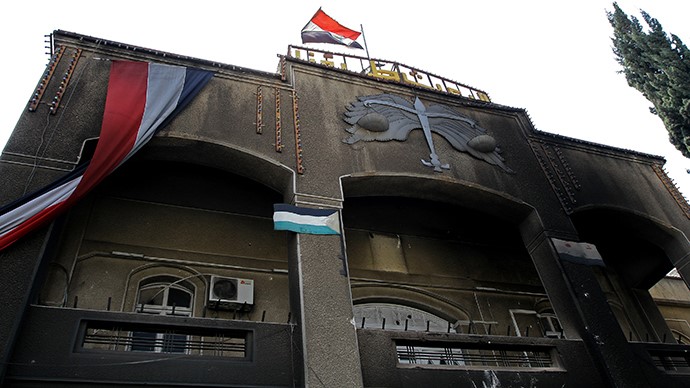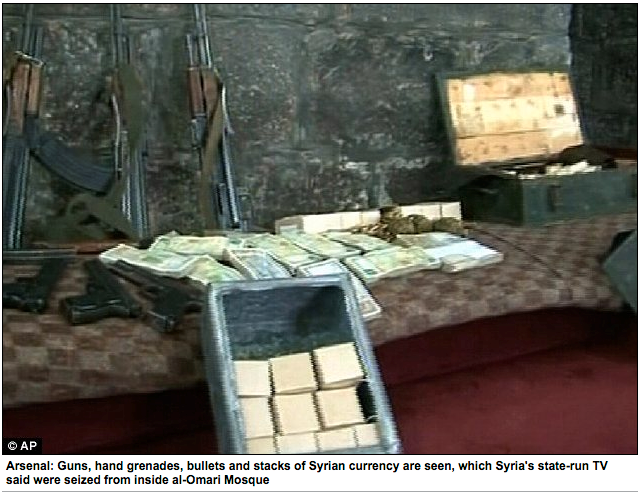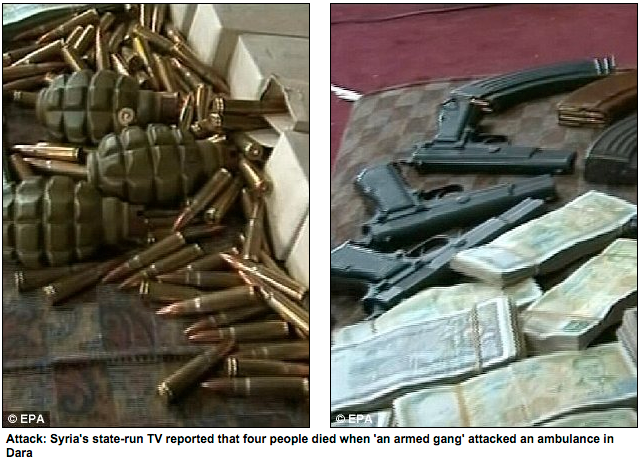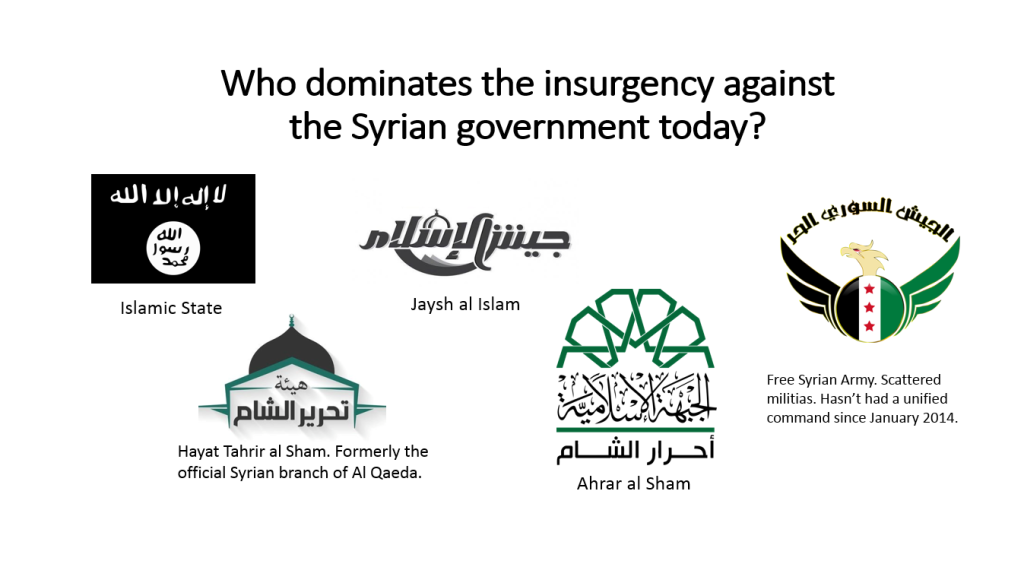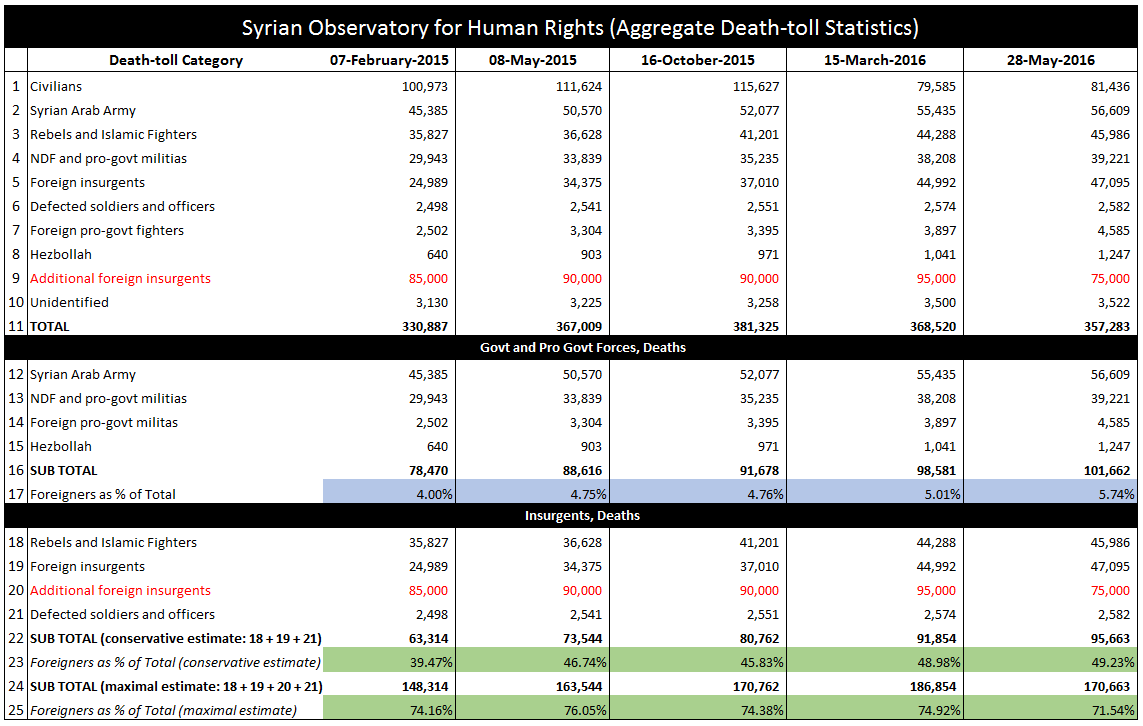Pamphlet Guide With Links
Countering War Propaganda
“The Assad regime shot peaceful protesters which started the war”
No. Most likely unidentified gunmen in Daraa shot at police officers and civilians. By 23 March 2011 (first six days of war) 24 out of the 37 killed in Daraa were Syrian government soldiers – were they killed by ‘peaceful protestors’?
See Interview with Alaa Ebrahim, the journalist who covered the opening events in Daraa.
The first armed confrontations between government forces and an insurgency happened on the 17 and 18th of March 2011 in Daraa. They resulted in, the deaths of 4 protesters and 7 police officers, and a few days later on the 21st of March, the burning down of the Baath party headquarters and courthouse. That more police officers were killed than civilians (here ‘civilian’ means a non-state actor but not necessarily a non-combatant) suggests an armed confrontation between two sides, and not the violent suppression of an unarmed crowd.
Firstly, the earliest allegation that the state was gunning down “protesters” came on the 23rd of March 2011, just six days after the initial outbreak of violence in Daraa in a report by Reuters correspondent Suleiman Khalidi. The international media, led by Al Jazeera and Al Arabiya, pounced on these events to accuse the Syrian government of firing on peaceful protesters often citing the claims of anonymous “opposition activists”.
The report reads:
“President Bashar al-Assad made a rare public pledge to look into granting Syrians greater freedom on Thursday as anger mounted following attacks by security forces on protesters that left at least 37 dead…The main hospital in Deraa, near the Jordanian border, had received the bodies of at least 37 protesters killed on Wednesday [the 23rd of March], a hospital official said.”
Here the number “37” doesn’t refer specifically to “protesters” but to the total number killed and taken to Daraa’s hospital.
According to political analyst Prem Shankar Jha:
“Suleiman Khalidi, the local correspondent of Reuters, reported on March 23 that 37 bodies had been brought to the Dera’a hospital till then. The number was intriguing because all news reports had been unanimous that 13 civilians had been killed till March 23, so where did the other 24 bodies come from?”
As it turned out the other 24 bodies were SAA soldiers who were killed in an ambush. According to a detailed investigative report titled ‘The Hidden Massacre’ by journalist Sharmine Narwani, this massacre was carried out by insurgents ambushing a truck of SAA soldiers who had been called to enter Daraa after the initial violent incidents on the 17-18th of March, 2011.
The massacre unfolded as follows according to Narwani:
“Several old Russian-made military trucks packed with Syrian security forces rolled onto a hard slope on a valley road between Daraa al-Mahata and Daraa al-Balad. Unbeknown to the passengers, the sloping road was slick with oil poured by gunmen waiting to ambush the troops. Brakes were pumped as the trucks slid into each other, but the shooting started even before the vehicles managed to roll to a stop.”
The lack of coverage about this massacre was actually because the Syrian government made efforts to conceal this from the media.
According to Syria’s Deputy Foreign Minster Dr. Faisal Mekdad it was for the following reason:
“this incident [the ambush killing 24 SAA soldiers] was hidden by the government and by the security for reasons I can interpret as an attempt not to antagonize or not to raise emotions and to calm things down – not to encourage any attempt to inflame emotions which may lead to escalation of the situation – which at that time was not the policy.”
Even though the majority killed were SAA soldiers, Khalidi’s article nonetheless alleges that the 37 killed were “protestors”, which was picked up by other news outlets, especially Al-Jazeera and Al-Arabiya, and used to characterise the conflict as having began with Syrian government shooting innocent protestors.
“the rebels started off secular”
The first battle led government forces to the al Omari Mosque in Daraa where stockpiles of cash and weapons were seized. The Mosque is a hotbed of ‘Islamist’ chauvinism led by a well-known sectarian cleric. The Saudis admitted to arming these fighters in a BBC interview.
The Army (SAA) was immediately called into Daraa because those police officers had reportedly been killed by snipers; what followed were gun battles that led to the Army to the Al-Omari Mosque, where [according to video footage obtained from Syrian state TV by the Daily Mail UK – shown below] they seized a stash of Kalashnikov rifles, semi-automatic pistols, hand-grenades, and large quantities of Syrian currency.
It should be noted that the Al-Omari Masjid is known for its extreme theocratic ambitions, and also for its infamous blind preacher Sheikh Ahmed Siyasanah, who spoke at a Hezb ut Tahrir conference in Lebanon in 2012, denouncing the government with a sectarian rant about the evils of secularism, and referring to the Syrian government as “a regime that has made war against Allah, and war against Islam for many decades”. The cleric also claimed that government soldiers entered the Al-Omari masjid, and scribbled in Farsi “do not make sajdah [prostrate] to Allah, but make sajdah to Bashar” over copies of the Quran.
It has since been revealed that this practice of defacing mosques with abusive sectarian messages deemed blasphemous to Sunni Muslims (let alone to Muslims in general) were false flag actions intended to portray the Syrian government and its army as being, inherently sectarian, dominated by the minority Alawi community, and also antagonistic towards Syria’s Sunni Arab majority.
Evidence of these false-flag operations emerged in March 2014 when a Tunisian insurgent who fought in Syria before returning home, admitted on Tunisian television that he was tasked with desecrating mosques named after prominent figures in Sunni Islam (such as Abu Bakr, Uthman, and Aisha) in order to encourage defections from Syria’s predominantly Sunni armed forces.
“the revolution is still mainly secular”
The most powerful militias fighting the government today are: Islamic State, Tahrir al Sham (formerly Al Qaeda), Ahrar al Sham, and Jaysh al Islam – all Salafi Islamist, all openly against democracy. The so-called ‘secular’ FSA are the weakest of all, and have no unified leadership. The dominate militias all call for the genocide of religious minorities.
Q: Who would take power if the state collapsed? Most likely the war would continue along the lines of Islamic State vs. Other ‘Islamists’ until Syria has been ‘softened’ up for invasion like Afghanistan to defeat those ‘we’ funded in the first place.
“Assad is a dictator”
What did the actual peaceful protesters want before the war began? Democratic reforms. Did Assad’s government address those demands. Yes. In Feb 2012 a new constitution was voted in which ended enshrined Baathist political hegemony and introduced multi-candidate presidential elections.
Q: Does it seem logical that peaceful protesters demanding democratic reforms would morph into armed Islamists openly denouncing democracy? That’s like believing Occupy Sydney morphed into Reclaim Australia.
In early 2011 and prior to the onset of armed conflict there had been a series of protests across Syria relating to a range of understandable political and economic grievances without calling for the government to be overthrown.
According to an Al-Jazeera article published on the 9th of February 2011, protestors demanded an end to the state of emergency, which granted police the right to detain suspects on spurious grounds (this particular law was repealed in April 2011), as well as constitutional reforms to end the Baath party’s political monopoly (which ended after the 2012 constitutional referendum). The economic grievances were against corruption, unemployment, and cost of living pressures, especially the rising cost of diesel fuel, and also regarding more specific issues such the monopoly of Syria’s mobile phone networks.
Al-Jazeera, which is owned by the very Qatari monarchy that has financed the anti-government insurgency, is no friend of the Syrian government, especially given its documented history of lying in ways that undermine the Syrian government’s reputation. Nonetheless the article admitted that the public perception of President Assad was of a leader keen on reform, but restrained by entrenched political structures. According to one Syrian student:
“The president knows that reform is needed and he is working on it…As for me, I don’t have anything against our president. The main issues which need to be addressed are freedom of speech and expression as well as human rights…Also, many things have changed since Bashar came to power, whether it has to do with road construction, salary raises, etc. Even when it comes to corruption, he is trying hard to stop that and limit the use of ‘connections’ by the powerful figures in Syria. However, he won’t be able to dramatically change the country with the blink of an eye.”
By the 16th of March, hundreds congregated in protest in Damascus and Aleppo and faced a heavy-handed response from the police who proceeded to briefly detain the organisers to break up the protests.
Syria’s highest elected body is the unicameral People’s Council (Majlis Al-Shaab), which is comprised of 250 seats that are divided proportionally among its 14 governorates. The President appoints their Cabinet, which consists of ministers with different responsibilities, from among the People’s Assembly.
There were major changes to Syria’s parliamentary system.
According to the old constitution the Baath party led a coalition of political parties known as the ‘National Progressive Front’ (1973: Art.8), which could legally contest elections for the People’s Council, meaning that candidates from outside these parties had to run as independents.This front was formed in 1972 and initially featured the following secular, leftist, and nationalist parties; the Syrian Communist Party, the Arab Socialist Union, the Arab Socialist Movement, and the Organisation of Socialist Unionists.
The new constitution introduced a multi-party political system in the sense that the eligibility of political parties to participate isn’t based on the discretionary permission of the Baath party or on reservations rather on a constitutional criteria. As such, the new constitution forbids political parties that are based on religion, sect or ethnicity, or which are inherently discriminatory towards one’s gender or race (2012: Art.8) – this means the Syrian Muslim Brotherhood is still banned.
What hasn’t changed is the constitutional requirement that half the People’s Council be comprised of ‘workers and peasants’ (1973: Art.53 | 2012: Art.60), which in practice means that the ballot paper contains two lists, one with candidates who qualify as ‘workers and peasants’, and another one with other candidates. Assuming the ‘workers and peasants’ quota isn’t filled, the next closest candidates would be prioritised for election.
According to the old constitution the Baath party was the “leading party in society and the state” (1973: Art.8), which in practice allowed the Baath party to propose their own Presidential candidate to run in an uncontested referendum, and if this candidate, hypothetically, failed to receive a majority of votes, the People’s Council (Syria’s unicameral parliament) would have the right to propose another candidate (1973: Art.84).
In the new constitution all references to the Baath party have been removed. To qualify as a candidate, the applicant must have the support of 35 members of the People’s Council (2012: Art.85), and must have lived in Syria for the past ten years (2012: Art.84) . If hypothetically only one candidate qualifies within these rules, the Speaker of the People’s Council’s must call for these qualifying procedures to be repeated.
What follows is a timeline of the Syrian government’s responses to popular demands:
17th of January, 2011: Prior to the anti-government insurgency, and in response to popular pressure, the government “increased the heating oil allowance for public workers by 72 percent to the equivalent of $33 a month”.
9th of February, 2011: The government lifts its ban on Facebook, Youtube, and Twitter, which had been in place since 2007.
13th of February, 2011: The government, through its newly established National Social Aid Fund, begins offering transfer payments to help Syria’s 420,000 poorest families.
15th of February, 2011: The government “reduc[es] duties on a range of basic foodstuffs including rice, tea, powdered milk, coffee and bananas. It also lowered taxes on vegetable oil, margarine, unroasted coffee and sugar”.
17-18th of March, 2011: The insurgency is launched in Daraa marking the beginning of the war.
23rd of March, 2011: After sending a delegation to Daraa to investigate events, President Assad sacks the unpopular Governor of Daraa, Faysal Kalthum, and orders the release of the fifteen teenagers who were detained for graffitying anti-government slogans.
20th of April, 2011: The government repealed the forty-eight year old state of emergency that had given police sweeping powers to carry out pre-emptive arrests and detain suspects.
20th of June, 2011: President Assad announces a national dialogue to begin a process of constitutional reform. One of the major demands is for an end to the constitutional privileges afforded to the Baath party.
26th of February, 2012: A constitutional referendum is held asking the electorate whether they approved the changes made to the constitution.
- 14.6 million Syrians were eligible and registered to vote out of a population of 23 million
- 8.4 million Syrians voted (57 percent participation rate)
- 7.5 million Syrians voted ‘yes’ for the new constitution (89 percent of the vote)
The new constitution, which replaced the one adopted in 1973, embodied many of the parliamentary and presidential reforms demanded by the democratic opposition.
7th of May, 2012: Syria’s parliamentary elections are held according to the new constitution to determine the composition of the 250 seat People’s Council.
- 10.1 million Syrians were eligible and registered to vote out of a population of 23 million
- 5.2 million Syrians voted (51 percent participation rate)
- The National Progressive Front won 168 seats (of which the Baath party won 134 seats)
- The Popular Front for Change and Liberation won 5 seats
- Independent candidates won the remaining 77 seats
Unlike the previous parliamentary elections, this time an opposition coalition of political parties, called the Popular Front for Change and Liberation, contested the elections against the Baath Party led National Progressive Front.
3rd of June, 2014: The first multi-candidate election according to the new constitution is held. It is contested between three candidates, the incumbent President Bashar Al Assad, Hassan Al Nour, and Maher Al Hajjar.
- 15.8 million Syrians were eligible and registered to vote out of a population of 23 million
- 11.6 million Syrians voted for three Presidential candidates (73 percent participation)
- 10.3 million Syrians voted for the incumbent President Assad (88 percent of the vote)
“the war is between the ‘ruling’ Alawite minority and the ‘oppressed’ Sunni majority”
This is the same narrative promoted by the four dominant Islamist militias. They know their Wahhabi ideology is foreign to Syria so they cover it up by appealing to majoritarian chauvinism. This has parallels in far-right propaganda accusing Jews of controlling the government.
“this is a popular revolution”
People who say this often dismiss the results of the 2014 presidential election in which Assad won 88% of the vote with 73% turnout, however this result is entirely consistent with media reporting. In Nov 2012 TIME Magazine interviewed an FSA fighter who admitted, “the Aleppans here, all of them, are loyal to the criminal Bashar”. In Jan 2013 Reuters interviewed another FSA fighter who put support for Assad at 70% in Aleppo. There is zero evidence that the majority support the government’s overthrow.
“Assad released Islamists from prison in order to make the revolution look bad”
Given that those Islamists are represented across the insurgency, why support the overthrow of the Syrian government by forces that you’re angry at Assad for releasing in the first place?
Facts About the War on Syria
1. US & British special forces were training mercenaries inside Syria to fight the government from the first year of the conflict (2011) (Wikileaks 2012)
2. Around 49-71% of dead insurgents are foreigners according to the Syrian Observatory for Human Rights which is an openly ANTI government source.
* Numbers sourced from following links: February 2015 , May 2015, October 2015, March 2016, and May 2016
3. The US was discussing plans to destabilise Syria INCLUDING by exploiting religious differences as early as 2006 (Wikileaks 2011).
4. The CIA has spent at least $1 billion on “Syria-related operations” including the training of up to 10,000 fighters in Turkey, according to documents obtained from Edward Snowden.
5. Saudi Arabia in early 2012 was committed to overthrowing the Syrian government “by all means available” according to a leaked Saudi memo published by Wikileaks.
6. By May 2013 Qatar had spent up to $3 billion arming the insurgency although “rebel and diplomatic sources put the figure at $1bn at most”.
7. In May 2013 the EU lifted their oil sanctions on Syria to make it legal for European entities to buy oil from Jabhat al Nusra (Syrian Al Qaeda) and later Islamic State via Turkey.
8. In May 2015 Britain joined “American-led efforts to train 5,000 Syrian insurgents every year for the next three years” to fight the Syrian government and Islamic State.
9. Israel has repeatedly bombed Syria to the benefit of the forces waging war against the Syrian state (this happened three days ago) who receive medical treatment in Israeli hospitals in the occupied Golan heights (illegally seized from Syria). Syrian government forces have also seized Israeli weapons from insurgents.
Nov 2012: ‘Israeli military scores ‘direct hits’ on Syrian artillery launcher in first open clash’
Jan 2013: ‘ISRAEL STRIKES SYRIAN WEAPONS EN ROUTE TO HEZBOLLAH’
Mar 2013: ‘Israel opens fire after ‘shooting from inside Syria’
May 2013: ‘Syria and Israel in exchange of fire’
Mar 2014: ‘ISRAEL STRIKES SYRIAN ARMY TARGETS IN RESPONSE TO ATTACK ON IDF JEEP’
June 2014: ‘Israel launches airstrikes in Syria after teen is killed’
Mar 2017: ‘Israel carries out air strikes inside Syria’
Apr 2017: ‘Syria war: Israel Patriot missile downs ‘target’ over Golan’
Jun 2017: ‘IDF STRIKES SYRIAN TARGETS IN RESPONSE TO GOLAN CROSSFIRE’
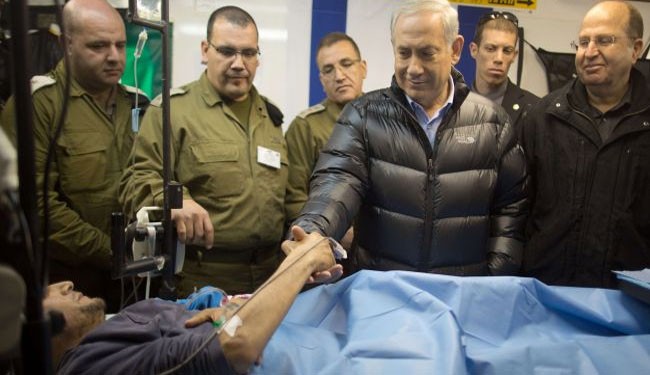
FEB 2014: Israeli regime’s Prime Minister Benjamin Netanyahu visits injured anti-Syria insurgents in an Israeli field hospital
